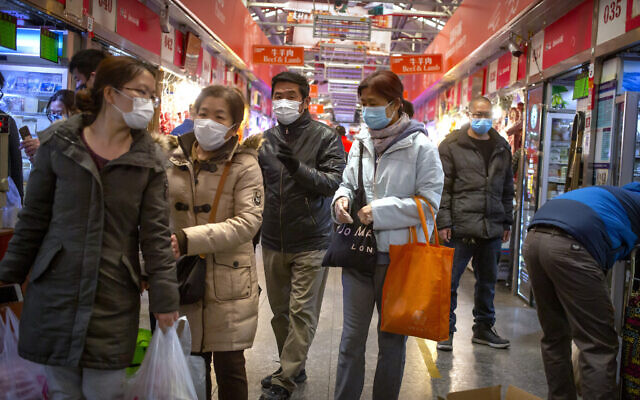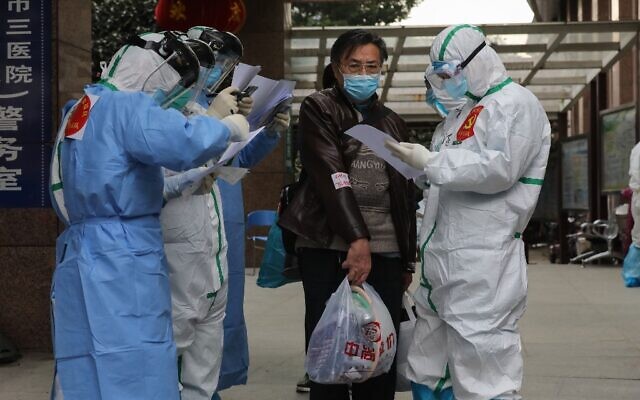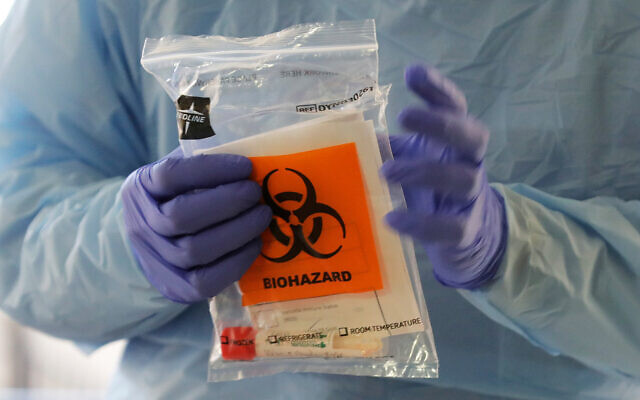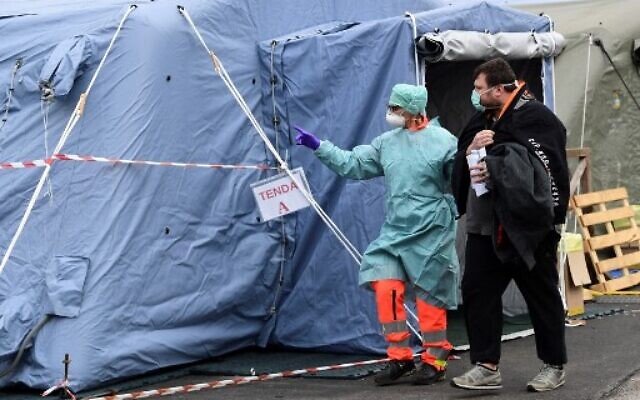Beijing continues to ease up lockdown measures in hardest-hit Hubei province, where number of new cases dwindle
By YANAN WANG, TOI

People wear face masks as they shop at a market in Beijing, Saturday, March 14, 2020. (AP/Mark Schiefelbein)
BEIJING (AP) — As the rest of the world mobilized to fight the widening coronavirus pandemic on Saturday, China continued to ease up lockdown measures in its hardest-hit region, where the number of new cases has dwindled.
The virus that first emerged in central China late last year has in recent weeks spread exponentially in the Middle East, Europe and North America, leading US President Donald Trump to declare a state of emergency for the United States on Friday.
With hopes of quick containment dashed, dozens of countries have imposed increasingly severe measures over the past couple days — shutting borders, closing school for tens of millions of children and ordering tens of thousands of businesses to close their doors — to try to face down the disease.
New Zealand on Saturday announced all incoming passengers, including New Zealand citizens, will be required to isolate themselves for 14 days, with few exceptions.
The steps being implemented globally increasingly mirror those taken by China, which in January made the unprecedented decision to halt outbound transportation from cities with a combined population of more than 60 million people, starting with the epicenter of Wuhan in the central province of Hubei.

Medical staff check information as patients infected by the COVID-19 coronavirus leave from Wuhan No.3 Hospital to Huoshenshan Hospital in Wuhan in China’s central Hubei province on March 4, 2020 (STR / AFP)<
>
<
>
The spread of COVID-19 in the country has slowed dramatically, according to China’s National Health Commission. Whereas the commission reported thousands of new cases daily only one month prior, it said Saturday that there were 13 new deaths and just 11 new cases, including people who recently arrived in China from other affected countries like Italy. More than 65,000 people have recovered from the disease in China.
While the new coronavirus can be deadly, particularly for the elderly and people with other health problems, for most people it causes only mild or moderate symptoms, such as fever and cough. Some feel no symptoms at all and the vast majority of people recover.
The government of Hubei lowered its health risk assessments for all counties in the province outside of Wuhan, which is the only city that remains “high-risk.” Several Hubei municipalities are gradually resuming public transportation services and re-opening businesses.
Waning outbreaks in Asia stand in contrast with an escalating number of infections elsewhere.
In the US, which reported its 50th death from the outbreak Friday, Trump said the new emergency decree will open up $50 billion for state and local governments to respond to the outbreak. Trump said the decree also gave the secretary of health and human services emergency powers to waive federal regulations to give doctors and hospitals “flexibility” in treating patients.

A nurse at a drive up COVID-19 coronavirus testing station, set up by the University of Washington Medical Center in Seattle, holds a bag containing a swab used to take a sample from the nose of a person in their car, March 13, 2020. (AP Photo/Ted S. Warren)<
>
<
>
Drug company executives vowed to work together and with the government to quickly expand the country’s coronavirus testing capabilities, which are far behind those in many countries.
“We will defeat this threat,” Trump told a news conference. “When America is tested, America rises to the occasion.”
Cases topped 1,700 across the US, where thousands of schools have been closed, concerts and sporting events canceled and even Broadway theaters shut down. Trump has halted his trademark political rallies, following the lead of Democratic rivals Joe Biden and Bernie Sanders.
New Zealand’s new measures, which Prime Minister Jacinda Ardern called some of the toughest border restrictions in the world, go into effect on Monday. The only countries exempt from the restrictions are a handful of Pacific islands which haven’t yet had any cases of COVID-19.
New Zealand has had only six confirmed cases of the illness. All of those have been connected with international travelers and there have been no signs yet of any local outbreaks.
The head of the World Health Organization said Europe was now the “epicenter of the pandemic.”

A hospital employee wearing a protection mask and gear, escorts a patient towards the radiology unit at a temporary emergency structure set up outside the accident and emergency department, where any new arrivals presenting suspect new coronavirus symptoms are being tested, at the Brescia hospital, Lombardy, on March 13, 2020. (Miguel Medina/AFP)<
>
<
>
Reflecting that reality, the government of the Czech Republic made a middle-of-the-night announcement ordering retail businesses including shopping malls to close as of Saturday morning.
The exceptions include those providing essential services such as supermarkets, gas stations and pharmacies.
New infections in Italy soared Friday by more than 2,500 and virus-related deaths made their biggest single-day jump there, increasing by 250. In the three weeks since the country identified its first virus cluster, Italy has reached a total of 17,600 confirmed cases, with 1,266 deaths. The government has ordered an unprecedented lockdown, ordering businesses to close and restricting movement.
New infections also rose sharply in Spain, and the government put 60,000 people in four towns on a mandatory lockdown Friday that echoed Italy’s. In Madrid, which is struggling with nearly 2,000 infections, many in nursing homes, the government was pooling intensive care units and considering offers by hotel chains to transform rooms into sick wards.
In just 24 hours, the numbers of confirmed cases spiked ominously in some places: France saw an additional 800 cases to reach more than 3,600 by Friday; Britain went from 590 to 798 and New York state jumped 30 percent, hitting 421. In Africa, where experts warn that containment is key because of the continent’s already-strained health care systems, six new countries confirmed infections.
In South America, Colombia’s president has ordered his nation’s border with Venezuela closed as a containment measure. Iván Duque announced late Friday that all official border crossings with the neighboring Andean nation will be shuttered beginning at 5 a.m. Saturday.
The two nations share a porous 1,370-mile (2,200-kilometer) border that is crossed by thousands of Venezuelans each day searching for food and medicine. Many also cross to permanently leave their nation’s economic crisis.
The spreading pandemic showed that power and influence offer no protection. Among those testing positive were the Canadian prime minister’s wife, a top aide to Iran’s supreme leader, Miami’s mayor, a Brazilian official who met with Trump, and an Australian Cabinet minister who met with the US attorney general and Trump’s daughter, Ivanka.
Pressed by reporters, Trump, who also met with the Brazilian official, said he will “most likely” be tested for the virus “fairly soon,” reversing an earlier White House statement.
<
>



@ Reader:
Bulgaria is locked down until March 29. Everything closed except markets, drugstores, banks, etc. Yesterday I stood on line to get into Lidl, a big supermarket. Only a few people allowed in at a time. Lots of food but no toilet paper. Streets almost empty. Most E. Europe borders closed.
@ adamdalgliesh:
“allof the East European countries have fewer reported coronavirus cases than any of the Western European countries.”
I suspect it’s because they have no political reasons to look for the virus and, therefore, have avoided the Western hysteria, so far.
The above BBC chart shows that allof the East European countries have fewer reported coronavirus cases than any of the Western European countries. Poland has very few, and Russia, Byelorussia and Ukraine have reported almost no cases.
Could this be because migrants from the Middle East and Africa
have not flocked to Eastern Europe in the same numbers as they have flocked to Western Europe? There are far fewer job opportunities in Eastern Europe, and the governments have been less welcoming of migrants there. Could it be that Italy has the highest number of COVID-19 cases because they have the most permissive policies toward migrants from these countries.
Hygienic conditions are very poor throughout the Middle East and Africa. They are especially bad in Syria and Iraq because of the wars there. People from these countries are more likely to be infected with and transmit infectious diseases than countries with better sanitary conditions.
https://www.bbc.com/news/world-51235105. Please rescue my most recent comment in this space from trash, Ted. from trash, Ted.
None of the East European countries have had as many cases Of COVID-19 as allthe countries of Western Europe. I derive this from a BBC chart that I don’t know how to reproduce here. (https://www.bbc.com/news/world-51235105).Russia, Byelorussia and Ukraine have reported almost none. None at all reported in Croatia. This seems to confirm my hypothesis that COVID-19 is mainly being spread by recently arrived immigrants/refugees from the Middle East and Africa. These migrants head to Western Europe, where there are job opportunities and welfare benefits, not to Eastern Europe, where there are fewer opportunities and the governments have made them less welcome.
Italy may have the most cases because they have admitted more recently migrants/refugees than any other country in Europe over th epast few years, and they have allowed them to circulate more freely around the country than elsewhere in Europe. But I assume that anyone who raises this point will immediately be shouted down as a racist.
We should have compared the COVID-19 epidemic with the 2009-2010 H1N1 “swine flu” epidemic before panicking. This epidemic killed far more people than the COVID-19 epidemic has so far. Yet the drastic measures now being adopted to stop the spread of COVID-19 were not adopted to stop it. The world and humanity survived. As a result, the 2008-09 recession was not made even worse.
” The 2009 flu pandemic or swine flu was an influenza pandemic that lasted from early 2009 to late 2010, and the second of the two pandemics involving H1N1 influenza virus (the first of them being the 1918–1920 Spanish flu pandemic), albeit a new strain. First described in April 2009, the virus appeared to be a new strain of H1N1 which resulted when a previous triple reassortment of bird, swine and human flu viruses further combined with a Eurasian pig flu virus,[4] leading to the term “swine flu”.[5] It is estimated that 11–21% of the then global population (of about 6.8 billion), or around 700 million–1.4 billion people, contracted the illness — more in absolute terms than the Spanish flu pandemic,[3][6] with about 150,000–575,000 fatalities.[7] A follow-up study done in September 2010 showed that the 2009 H1N1 flu was no more severe than the yearly seasonal flu.[8]” (From Wikipedia).
“While the new coronavirus can be deadly, particularly for the elderly and people with other health problems, for most people it causes only mild or moderate symptoms, such as fever and cough. Some feel no symptoms at all and the vast majority of people recover.” The relevant point.
“In Madrid, which is struggling with nearly 2,000 infections, many in nursing homes, . . .” Also relevant. Some specific population groups are heavily affected, but not very many people under the age of 60 who are in generally good health. To me, this suggests that restrictions on movement should be more limited and “targeted” to those most likely to become ill.
@ Sebastien Zorn:
In Chongqing, where I live, things are slowly returning to normal. For a population of 32 million it got off fairly easy – less than 600 cases, only 6 deaths, less than 50 remain in hospital the rest recovered and no new cases for a couple of weeks.. Although the schools have not opened, some stores and restaurants are slowly starting opening. Some that are essential such as supermarkets, banks, still require a fever check to enter (as does my apartment building) but even the small pharmacy I use now allows entry without fever check. However, everyone still wears masks. My wife’s niece went back to work a week ago.
I think that once the government got caught suppressing info at the beginning it has been open with it, and there are now WHO staff on site that reports to their superiors,so I think that the WHO reports can be relied upon.
Coronavirus humor:
https://img.elephantjournal.com/wp-content/uploads/2020/03/monalisa-4893660_1920-700×402.jpg
@ Michael S:
Oops — that’s a 92% chance of surviving, not 72%. You can’t trust these American statistics. 🙂
@ Sebastien Zorn:
Hello, Sebastian
I don’t know what statistics you’re talking about, nor what we want to “trust” about them. The Chinese have shown us the elephant in the living room. We may have to guess at exactly how much it weighs.
Here are some useful statistics:
Age Death Rate
80+ 14.8%
70-79 8.0%
60-79 3.6%
50-59 1.3%
40-49 0.4%
30-39 0.2%
20-29 0.2%
10-19 0.2%
If someone my age, for instance, is diagnosed with the virus, he has a 72% chance of surviving and an 8% chance of dying. Data from various places also suggests that women have better survival chances than men.
I have family in China. They were separated in distant cities by quarantines for several weeks because the virus hit during Chinese New Near. They have now been reunited, and under partial quarantine. The children, for instance, do their studies online.
Can we trust the Chinese government’s statistics?